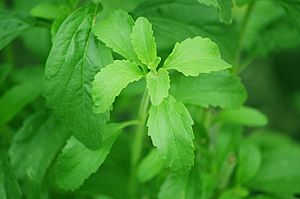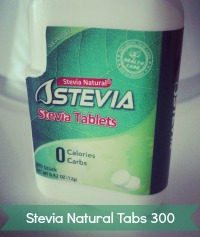Stevia facts for kids
Stevia is a natural sweetener and sugar substitute. It comes from the leaves of the Stevia rebaudiana plant, which grows naturally in Paraguay and Brazil.
The sweet parts of stevia are called steviol glycosides. The main ones are stevioside and rebaudioside. These compounds are super sweet, about 50 to 300 times sweeter than regular sugar! They also stay stable in heat and different acid levels, and they don't ferment. Our bodies don't break down these sweet compounds, so stevia has zero calories. It's known as a non-nutritive sweetener. Stevia's sweetness takes a little longer to notice and lasts longer than sugar. Some people say that highly concentrated stevia extracts can have a slight aftertaste that reminds them of licorice or is a bit bitter. Stevia is often used in foods and drinks that are low in sugar and calories, as a healthy choice instead of sugar.
The rules for using stevia as a food additive or dietary supplement are different in various countries. In the United States, pure stevia extracts have been considered "generally recognized as safe" (GRAS) since 2008. This means they are allowed in food. However, whole stevia leaves or less pure extracts are not approved for food use there. The European Union approved stevia additives in 2011. In Japan, stevia has been a popular sweetener for many decades.
The Guaraní people of South America have used the Stevia rebaudiana plant for over 1,500 years. They called it ka'a he'ê, which means "sweet herb." For hundreds of years, people in Paraguay and Brazil traditionally used the leaves to sweeten teas and medicines, and as a sweet snack. The plant's name, Stevia, comes from Pedro Jaime Esteve, a Spanish botanist from the 1500s.
In 1899, a Swiss botanist named Moisés Santiago Bertoni was exploring in Paraguay. He was the first to describe the plant and its sweet taste in detail. Not much research happened after that until 1931. Then, two French chemists successfully separated the sweet compounds (glycosides) from stevia.
Contents
Stevia's Journey to Approval
In the 1990s, the United States Food and Drug Administration (FDA) received requests to approve stevia as "generally recognized as safe" (GRAS). However, the FDA didn't agree at first. Stevia was not allowed in food until a law in 1994 changed things. After this, the FDA allowed stevia to be sold as a dietary supplement, but still not as a food additive.
In 1999, some early studies made the European Commission ban stevia in food products in the European Union. They wanted more research. But in 2006, the World Health Organization looked at all the research and found no harmful effects from stevia.
In December 2008, the FDA finally gave its approval for highly purified stevia extracts like Truvia and PureVia to be considered GRAS. These products use rebaudioside A from the stevia plant. The FDA made it clear that these purified extracts were different from whole stevia leaves. By 2017, high-purity stevia extracts were considered safe and allowed in food products sold in the United States.
How Stevia Became Popular
In the early 1970s, other sweeteners like cyclamate and saccharin were being removed from drinks like Coca-Cola. This led to Japan starting to use stevia as an alternative. A Japanese company, Morita Kagaku Kogyo Co., Ltd., made the first commercial stevia sweetener in 1971. Japanese people have been using stevia in foods, soft drinks (including Coca-Cola), and at their tables ever since. By 2006, Japan used more stevia than any other country, with stevia making up 40% of their sweetener market.
In the mid-1980s, stevia became popular in the U.S. in natural foods and health food stores. People used it as a zero-calorie natural sweetener for teas and weight-loss products.
By 2006, China was the biggest exporter of stevia products in the world. In 2007, the Coca-Cola Company announced plans to get approval for its stevia-based sweetener, Rebiana, in the United States. They also planned to sell Rebiana-sweetened products in 12 other countries where stevia was already allowed.
In May 2008, Coca-Cola and Cargill launched Truvia. This is a stevia sweetener for consumers that contains erythritol and Rebiana. The FDA approved it as a food additive in December 2008. Coca-Cola then started releasing drinks sweetened with stevia. From 2013 onwards, Coca-Cola Life, which uses stevia, was launched in many countries.
Soon after, PepsiCo and Pure Circle introduced their own stevia-based sweetener called PureVia. Both Coca-Cola and PepsiCo have since launched many products that use these new stevia sweeteners.
Making Stevia Extracts
Rebaudioside A is the part of the stevia plant that tastes the least bitter among all the sweet steviol glycosides. To make rebaudioside A for sale, stevia plants are dried. Then, the sweet compounds are pulled out using water. This first extract is about 50% rebaudioside A. The different sweet compounds are then separated and made pure using special cleaning methods, often with alcohol.
Stevia extracts and products are made in factories and sold under different brand names:
- Rebiana is a shorter name for the stevia extract, rebaudioside A.
- Truvia is a brand of sweetener made by Cargill and Coca-Cola. It mixes erythritol with rebiana.
- PureVia is PepsiCo's brand of rebiana.
How Stevia Tastes Sweet
Glycosides are molecules that have sugar parts connected to other non-sugar parts. When you taste stevia, the sweet compounds (glycosides) react with the taste receptors on your tongue. This creates the sweet taste sensation. Some research suggests that stevia's sweet compounds also interact with a special protein channel in your taste buds called TRPM5. This interaction makes the sweet signal even stronger, which helps explain why stevia is so sweet. Some stevia compounds, like rebaudioside A, are perceived as sweeter than others, like stevioside.
After you eat stevia, the sweet compound called steviol cannot be further digested in your digestive system. It goes into your blood, is processed by your liver, and then leaves your body in your urine.
In 2019, scientists created a 3D map of the proteins in the stevia plant. This map showed the tiny structures that create both the sweet taste and the slight bitter aftertaste of the sweetener.
Is Stevia Safe?
A review in 2010 suggested that using stevia sweeteners instead of sugar could be good for children, people with diabetes, and anyone trying to eat fewer calories.
Some early lab tests showed that steviol and rebaudioside A might cause changes in cells (be mutagenic). However, these effects have not been seen in humans at the amounts typically consumed. Two studies from 2010 found no health problems with stevia or its sweet extracts.
The World Health Organization's committee on food additives has approved a safe daily amount of steviol glycoside. This is up to 4 milligrams per kilogram of body weight. In 2010, the European Food Safety Authority also set the same safe daily amount.
In August 2019, the US FDA issued a warning about importing stevia leaves and crude extracts. These forms of stevia are not considered GRAS, and the FDA had concerns about their safety and possible toxicity. However, highly purified stevia glycosides are still allowed and considered safe in the United States.
Where Stevia is Allowed
Stevia plants can be grown legally in most countries. However, some countries have rules about using stevia as a sweetener. The allowed uses and maximum amounts of stevia extracts can be very different from one country to another.
Here are some examples:
- Australia and New Zealand: All steviol glycoside extracts were approved in 2008.
- Brazil: Stevioside extract has been approved as a food additive since 2005.
- Canada: Steviol glycosides became allowed as a food additive in November 2012. Stevia leaves and extracts are also available as dietary supplements.
- China: Stevia has been available since 1984.
- European Union: Steviol glycosides were approved as food additives in November 2011.
- India: The FSSAI allowed stevia in many products, including carbonated water, dairy desserts, yogurts, and fruit jams, in November 2015.
- Japan: Stevia has been widely used since the 1970s and regulated as an existing additive since 1995.
- United States:
* Pure rebaudioside A has been allowed as a food additive (sweetener) since December 2008. It is sold under different brand names and is considered "generally recognized as safe" (GRAS). * However, Stevia rebaudiana leaves and crude extracts have been available as dietary supplements since 1995, but they are not considered GRAS for food use. In 2019, the FDA raised concerns about their safety for use in foods or supplements.
See also
 In Spanish: Estevia (edulcorante) para niños
In Spanish: Estevia (edulcorante) para niños




